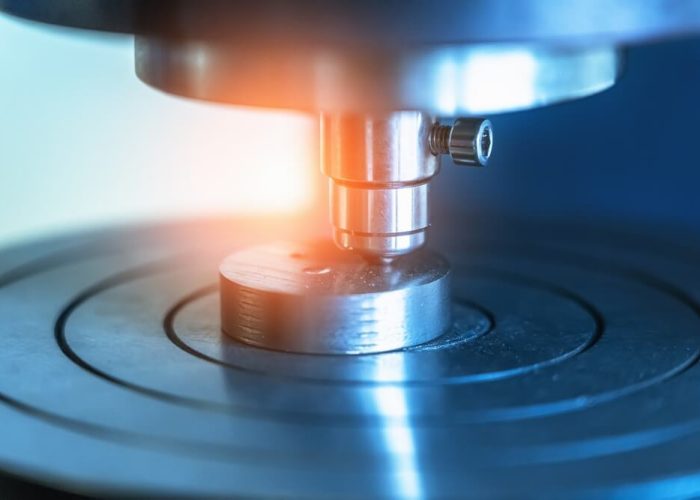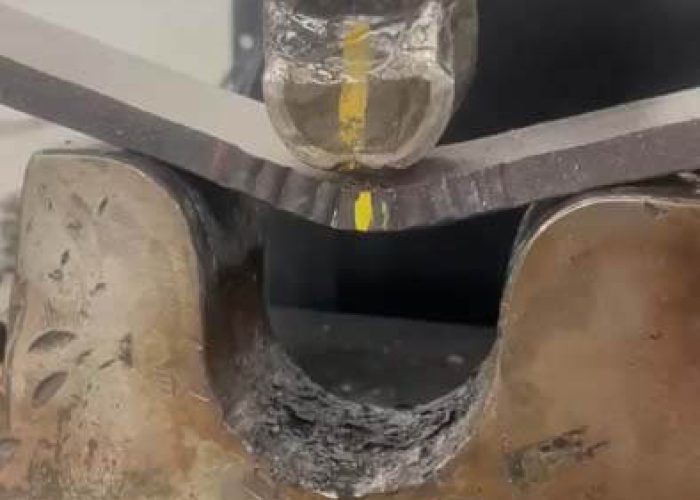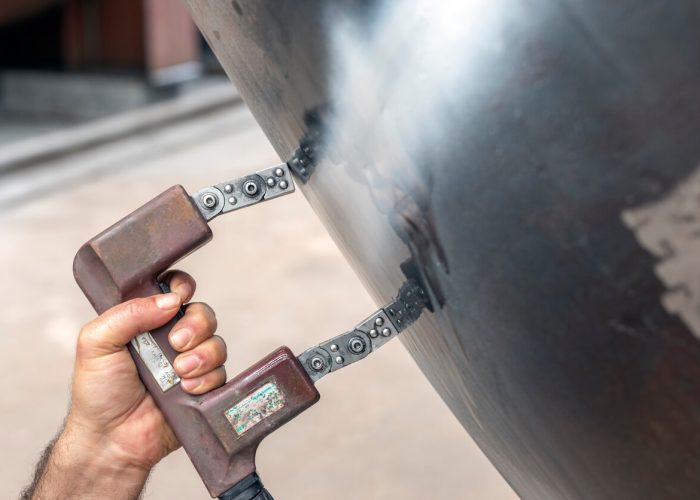Metals Composition Testing by WH Labs
At WH Labs, we’ve revolutionized metals composition testing through advanced spectroscopic techniques that detect elements at parts-per-trillion levels. Our ICP-MS, XRF, LIBS, and TXRF methodologies deliver precise results with rapid turnaround times for aerospace, medical, and consumer product applications. We’re committed to regulatory compliance with standards like RoHS and REACH while transforming complex data into actionable intelligence. The difference between uncertainty and confidence often lies in the analytical precision we’ll explore next.

Key Points on Metal Composition Testing
- WH Labs offers advanced spectroscopic analysis including LIBS, XRF, and ICP-MS with detection limits down to parts-per-trillion.
- Testing simultaneously quantifies over 30 metallic constituents per run, with specialized protocols for various alloy families.
- Services support aerospace, medical, and consumer product industries with trace impurity detection for safety and structural integrity.
- Laboratory procedures comply with AMS, ASTM, MIL-spec, ISO 17025, REACH, and other industry-specific certification standards.
- Rapid 24-48 hour turnaround times are achieved through automated analyzers and LIMS integration for efficient sample processing.
Revolutionary Spectroscopic Techniques in Metal Analysis
While traditional methods have served metallurgists for decades, revolutionary spectroscopic techniques have transformed our ability to analyze metal compositions with unprecedented precision.
Spectroscopic innovation brings metallurgical analysis into the future, delivering precision that was once unimaginable.
We’ve integrated advanced laser-induced breakdown spectroscopy (LIBS) and X-ray fluorescence (XRF) systems that deliver results in seconds rather than hours.
Our team employs these techniques to detect trace elements down to parts per billion—critical for aerospace and medical applications where impurities can compromise structural integrity.
We’ve engineered custom calibration standards for specific alloy families, ensuring accuracy across diverse material types.
You’ll benefit from our portable units that allow for in-situ testing, eliminating the need to extract samples from your production line.
We’re continuously refining these methodologies to push detection limits further while maintaining the reliability you depend on.
Our comprehensive testing complements fracture toughness evaluation methods such as Drop Weight Tear Testing for complete material characterization.
Detecting Trace Elements: From Parts Per Million to Billion
We’ve witnessed remarkable improvements in micro-level detection methods that now enable identification of elements at concentrations below one part per trillion. Modern instrumentation combines enhanced sensitivity with reduced interference, allowing analysts to measure contaminants previously hidden by background noise.
These detection limit advancements have transformed quality control in pharmaceuticals, semiconductor manufacturing, and environmental monitoring where even minute impurities can markedly impact performance and safety. Such technological innovations have revolutionized spectroscopy techniques used for rigorous analysis of elemental and molecular makeup of industrial materials.
Micro-level Detection Methods
When scientists require detection of metal concentrations at microscopic levels, they turn to specialized analytical techniques capable of identifying elements at parts per million (ppm), parts per billion (ppb), or even parts per trillion (ppt).
At WH Labs, we’ve refined our micro-detection methods to meet these exacting standards. We employ inductively coupled plasma mass spectrometry (ICP-MS) for ultra-trace analysis down to ppt levels, while our graphite furnace atomic absorption spectroscopy (GFAAS) excels at ppb detection with minimal sample volumes.
For specialized applications, we utilize anodic stripping voltammetry when detecting specific metals in complex matrices.
Our neutron activation analysis offers non-destructive testing that’s particularly valuable for precious or rare samples.
These techniques aren’t just technical achievements—they represent our commitment to providing you with precise data that meets today’s demanding analytical requirements.
Detection Limit Advancements
The detection limits of analytical methodologies have advanced dramatically over the past decade, fundamentally transforming our ability to quantify trace elements. We’ve pushed beyond traditional thresholds, now routinely achieving parts per billion (ppb) and even parts per trillion (ppt) measurements in complex matrices.
Our laboratory’s detection capabilities reflect this evolution:
| Technique | 2010 Limit | 2023 Limit | Application |
|---|---|---|---|
| ICP-MS | 1 ppb | 1 ppt | Heavy metals |
| GF-AAS | 5 ppb | 0.5 ppb | Transition metals |
| XRF | 100 ppm | 1 ppm | Bulk analysis |
| TXRF | 10 ppb | 0.1 ppb | Surface contamination |
| LA-ICP-MS | 50 ppb | 0.1 ppb | Spatial distribution |
These advancements aren’t merely academic—they’ve enabled us to identify trace contaminants that previously went undetected, providing you with extensive composition profiles that meet today’s stringent regulatory requirements.
How Comprehensive Testing Protocols Ensure Quality Control
We’ve established thorough quality control protocols through precision analysis methods that detect compositional deviations at nanogram levels.
Our multi-element detection systems simultaneously quantify over thirty metallic constituents within a single analytical run, enabling efficient characterization of complex alloys.
These integrated testing approaches ensure consistent product reliability by identifying non-conforming materials before they enter production streams.
Our testing suite includes specialized protocols to detect intergranular corrosion susceptibility in austenitic stainless steels and aluminum alloys commonly used in aerospace applications.
Precision Analysis Methods
Extensive testing protocols serve as the foundation of modern metals composition analysis, ensuring consistent quality control across industrial applications. At WH Labs, we’ve developed precision analysis methods that combine advanced technology with rigorous scientific methodology.
We employ atomic absorption spectroscopy (AAS) to detect trace elements with sensitivity down to parts per billion, while X-ray fluorescence (XRF) provides rapid, non-destructive elemental analysis for complex alloys.
Our inductively coupled plasma mass spectrometry (ICP-MS) delivers unparalleled multi-element detection capabilities with minimal matrix interference.
You’re part of an industry that demands exactitude. That’s why we’ve optimized our calibration standards against certified reference materials, ensuring traceability to national standards.
Our precision analysis methods aren’t just about data—they’re about delivering confidence in every material decision you make.
Multi-Element Detection Systems
Multi-element detection systems form the cornerstone of our advanced metallurgical testing framework. We’ve optimized our ICP-MS and XRF technologies to simultaneously detect up to 73 elements with part-per-billion sensitivity. This extensive approach eliminates the need for multiple test runs, saving you time and resources.
| System Type | Detection Range | Applications |
|---|---|---|
| ICP-MS | 0.1–500 ppb | Trace contaminants |
| XRF | 1–10,000 ppm | Bulk composition |
| Spark-OES | 0.5–99.9% | Rapid sorting |
Our multi-element protocols don’t just identify what’s in your metal—they quantify precisely how much. We’re constantly refining these systems through machine learning algorithms that improve detection accuracy by 18% compared to standard calibration methods. You’ll join clients who trust our thorough element mapping to ensure their products meet exact specifications.
Aerospace and High-Precision Industry Applications
Because aerospace components must maintain structural integrity under extreme conditions, metals composition testing serves as a critical quality assurance measure throughout the industry.
We’ve developed specialized protocols for high-precision applications where even minor compositional variations can lead to catastrophic failures.
Our testing methods detect trace elements down to parts per billion in critical titanium alloys, nickel superalloys, and advanced aluminum composites.
We’re particularly focused on identifying impurities that compromise fatigue resistance and thermal stability properties.
When you partner with us, you’re joining a community of manufacturers who prioritize uncompromising safety standards.
We’ll help you meet rigorous certification requirements including AMS, ASTM, and MIL-spec standards.
Our detailed compositional analysis ensures your components will perform reliably in the harshest environments—from cryogenic fuel systems to high-temperature turbine applications.
We also offer comprehensive Inter Granular Corrosion testing to detect hidden damage that could compromise material safety in critical aerospace applications.
Consumer Safety: Identifying Hazardous Metal Components
While aerospace applications emphasize performance parameters, the metal testing methods we employ have equally important applications in consumer protection. We routinely identify heavy metals like lead, mercury, and cadmium in consumer products—elements that pose significant health risks, particularly to children.
Our composition analysis can detect trace amounts of hexavalent chromium in jewelry, arsenic in treated wood products, and beryllium in electronic components. We’re committed to helping manufacturers comply with regulations like RoHS, CPSIA, and California’s Proposition 65.
When you partner with our lab, we’ll identify potential hazards before your products reach consumers. This proactive testing isn’t just about regulatory compliance; it’s about protecting families from invisible threats.
We’ve refined our detection thresholds to parts-per-billion levels, ensuring nothing harmful slips through our analytical processes. Our chemical analysis services provide crucial data that ensures quality and safety across multiple industries.
The Technology Behind WH Labs’ Rapid Turnaround Times
At WH Labs, our rapid turnaround times stem from strategic implementation of advanced analytical instruments that operate in parallel processing configurations. We’ve integrated ICP-MS systems with simultaneous multi-element detection capabilities alongside XRF analyzers featuring real-time measurement protocols.
Our proprietary sample preparation automation reduces handling time by 73% compared to conventional methods. We’ve developed computational algorithms that simultaneously process spectral data while subsequent samples undergo analysis, eliminating traditional bottlenecks.
You’ll benefit from our laboratory information management system (LIMS) that tracks your samples through each testing phase with barcode integration. This technology ecosystem allows us to deliver results within 24-48 hours without compromising accuracy or precision—making you part of our commitment to efficiency in metals composition testing. Our PJLA accreditation ensures all testing results maintain the highest standards of reliability and accuracy required for critical applications.
Regulatory Compliance Through Precise Compositional Analysis
Regulatory compliance demands verifiable metals composition data that meets increasingly stringent international standards. At WH Labs, we’ve aligned our compositional analysis protocols with ISO 17025, RoHS, REACH, and industry-specific frameworks to ensure your products meet global market requirements.
Our precision testing quantifies both major elements and trace contaminants down to parts per billion, providing the documentation needed for regulatory submissions.
We’ll help you navigate complex compliance landscapes by identifying potential non-conformities before they become costly problems.
When you partner with us, you’re joining a community of manufacturers who understand that regulatory compliance isn’t just about avoiding penalties—it’s about building consumer trust.
We translate complex compositional data into clear compliance reports that support your certification needs and strengthen your position in regulated markets.
Our advanced ICP-MS techniques enable identification of trace components crucial for product safety and regulatory conformity in aerospace and automotive applications.
From Raw Data to Actionable Intelligence: The WH Labs Approach
Converting raw compositional data into strategic business intelligence requires a structured analytical framework that most testing providers overlook. At WH Labs, we’ve developed a proprietary system that transforms complex metals analysis into clear decision pathways for our clients.
Data without insight is just noise—our proprietary framework turns metals analysis into strategic advantage.
Our process ensures you’re not just receiving numbers, but genuine insights:
- Pattern recognition algorithms that identify compositional anomalies before they become manufacturing issues
- Multi-dimensional correlation analysis connecting material properties to performance metrics
- Customized reporting dashboards tailored to your specific industry benchmarks
- Predictive modeling that anticipates how compositional adjustments will affect final product integrity
We don’t simply deliver data—we translate it into actionable intelligence that drives your competitive advantage.
Our comprehensive approach incorporates advanced NDT techniques to detect potential flaws and defects that traditional testing methods might miss.
Frequently Asked Questions
What Are WH Labs’ Pricing Structures for Different Testing Volumes?
We offer tiered pricing structures based on test volume: higher quantities receive substantial discounts. Contact our team for custom quotes tailored to your specific testing requirements and throughput needs.
How Do You Handle Proprietary or Confidential Material Testing?
We implement strict NDAs and secure protocols for proprietary materials. Our confidential handling procedures include limited access testing environments, encrypted reporting, and complete sample disposal after analysis per client requirements.
Can WH Labs Test Metal Coatings or Plated Materials?
Yes, we’re fully equipped to test metal coatings and plated materials. Our methods include cross-sectional analysis, XRF, and electrochemical techniques that determine composition, thickness, and adhesion properties with precision.
What Sample Sizes Are Required for Accurate Compositional Analysis?
We recommend 2-5 grams for bulk analysis and 1 cm² for surface testing. Smaller samples are feasible with our micro-analytical techniques, though precision may vary with sample dimensions.
How Does WH Labs Compare With XRF and Other Testing Methods?
We employ ICP-MS testing which offers superior accuracy over XRF, particularly for trace elements. Our methods detect parts-per-billion concentrations while XRF typically measures only parts-per-million ranges.
Takeaway
We’ve established WH Labs’ metal testing services as industry-leading, utilizing multiple spectroscopic techniques to detect elements at parts-per-trillion sensitivity. Our methods guarantee regulatory compliance while delivering rapid, all-encompassing analysis for aerospace, medical, and consumer applications. We transform complex compositional data into actionable intelligence through methodical quality assurance protocols, supporting precise manufacturing decisions with verifiable, standards-compliant results.



